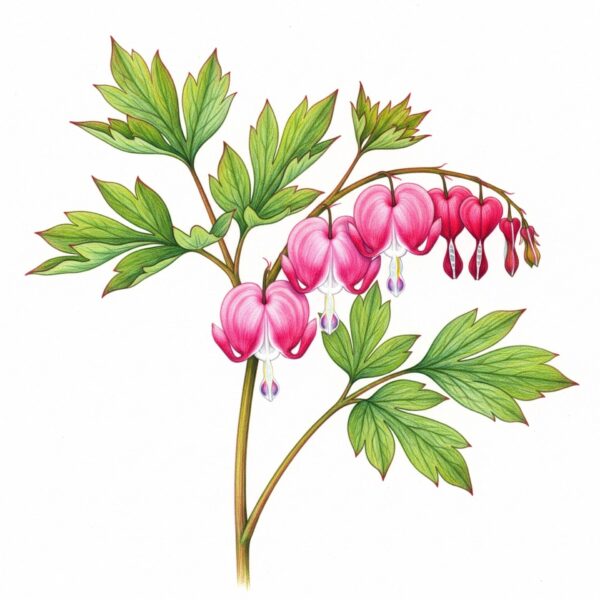Lamprocapnos spectabilis, commonly known as bleeding heart, is a cherished herbaceous perennial known for its distinctive and delicate flowers. Native to Siberia, Japan, northern China, and Korea, this plant is a staple in cottage gardens and shaded borders, where its graceful form and unique blooms add a touch of old-fashioned charm.
Description
Key Characteristics:
- Size: It typically grows in an upright, clumping habit, reaching a height and width of 2 to 3 feet (about 60-90 cm).
- Foliage: The plant features lush, fern-like, bluish-green foliage that emerges in early spring.
- Dormancy: A notable characteristic is that the foliage often dies back and goes dormant by mid-summer, especially in warmer climates or dry conditions. For this reason, it is often planted alongside later-blooming perennials like hostas and ferns that can fill the space.
Flowers and Blooming:
- Flowers: The most striking feature of the plant is its arching, leafless stems from which rows of small, heart-shaped flowers dangle. The flowers are typically a vibrant rose-pink with a protruding white tip at the bottom, giving them the appearance of a “bleeding heart.”
- Bloom Time: It is an early-season bloomer, with flowers appearing in late spring to early summer (April to May). The blooming period can last for several weeks.
- Pollinators: The flowers are a good source of nectar and attract bees.
Cultivation and Care
- Light: Bleeding hearts thrive in partial to full shade. While they can tolerate some sun, particularly in cooler climates, direct, hot afternoon sun can cause the foliage to scorch and the plant to go dormant early.
- Soil: They prefer rich, fertile, and well-drained soil that is consistently moist. Amending the soil with organic matter like compost or leaf mould is beneficial.
- Hardiness: Lamprocapnos spectabilis is very cold-hardy, typically surviving in USDA zones 3 to 9.
- Maintenance: It is a relatively low-maintenance plant. Minimal pruning is required; however, once the foliage begins to yellow and die back, it can be cut to the ground. This encourages the plant to store energy for the next year’s growth.
- Toxicity: It is important to note that all parts of the bleeding heart plant are considered toxic if ingested and the foliage can cause skin irritation in some people.
Common Names and Varieties
- The plant has been reclassified from Dicentra spectabilis to Lamprocapnos spectabilis, though it is still commonly known by its former name.
Popular cultivars include:
- ‘Alba’: Features pure white, heart-shaped flowers.
- ‘Gold Heart’: Has striking bright yellow-gold foliage that provides a stunning contrast to the classic pink flowers.
- ‘Valentine’: A cultivar with brilliant, deep cherry-red flowers and distinctive dark burgundy stems.
| See also different: | Easy-care perennial plants |

